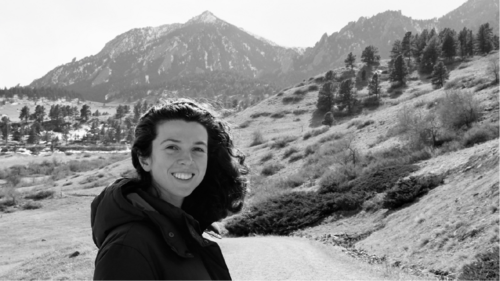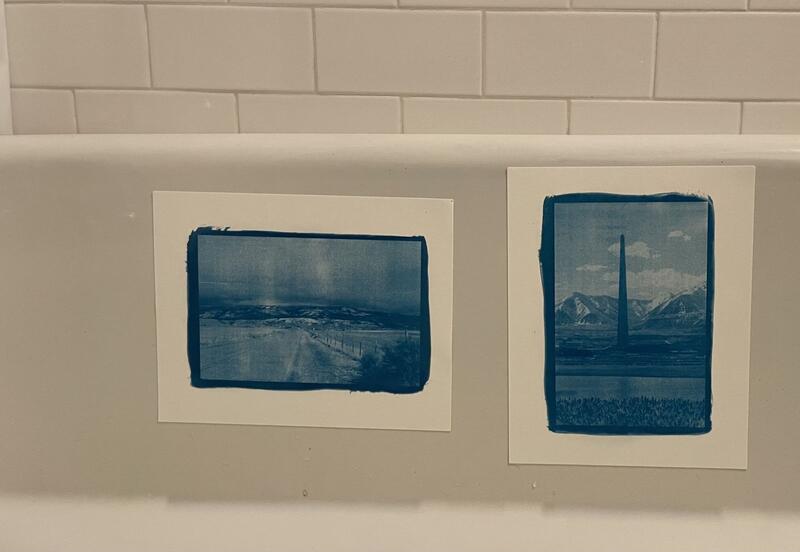
May 10, 2025
Charlotte Hecht is a Ph.D candidate in American Studies at Yale. She is a researcher and writer who draws on interdisciplinary methods from cultural and environmental history, geography, and visual studies to tell stories about power, place, and people. Her current work focuses on historical and contemporary landscapes impacted by layers of US militarism, scientific experimentation, and industrial production.
RH: For your grant project, “Unhomelike,” you focus on the history of US nuclear testing and the violence within that period of history. Can you elaborate on this history and why you wanted to explore this topic in particular? Why did you choose the name “Unhomelike” for the project?
CH: The Cold War-era US nuclear weapons testing program included the detonation of over 1,000 nuclear bombs, mainly at sites in the Marshall Islands and Nevada. Despite the incredible human and environmental cost that resulted from these tests—the displacement and destruction of Marshallese homes, the poisoning of land and bodies in communities (mostly poor, rural, and indigenous) that lived downwind from the detonations—this history has remained remarkably submerged in American collective memory. This is particularly true for those of us who are not from communities directly impacted. I did not learn about the extent of US nuclear testing until my first year of graduate school. I remember feeling shocked that in all my years of being in school and living in the United States, I had never really been taught about the full contours of this history.
In some ways, this project is a response to that gap in my own education. The name “Unhomelike” comes from Freud’s idea of the uncanny—an eerie feeling that a strange or unsettling event or thing is also familiar. In German, the word for uncanny is unheimlich, which when translated into English can be understood in a quite literal sense as unhomelike, or unhomeliness. The title of the project then, is meant as a reminder of how violent history like nuclear testing can hide in plain sight and become submerged into everyday life, in ways that are uncanny and familiar.
You mention in your grant project description that you have a personal connection to the topic of US nuclear testing, can you describe what that connection is and how it guided your exploration of this history?
In the midst of beginning research for my dissertation about the history of nuclear power (both bombs and energy), I discovered that my great-grandfather worked for the US government during his naval career to help plan and implement nuclear weapons tests in the Marshall Islands and in Nevada during the 1950s. I had not known this before, and it felt like a coincidence that was uncanny in the closeness that I suddenly had to the history that I was studying. I also felt a lot of conflicting feelings about his (and by extension, my family’s) involvement in actions that were so destructive. In this project I try to explore this tension—how to hold my love for my family in one hand, while acknowledging the violent realities of nuclear colonialism and militarism that are part of our history. So for me, the goals of this project are twofold—a chance to explore this personal question while also bringing awareness to a topic that has been obscured in American memory.
How has this project helped you grapple with that personal connection and how does it connect to your graduate studies? What insights have you gained from exploring these connections?
The form of this project is one of the ways that I’ve chosen to reflect on and to grapple with this connection. When I first learned about his involvement in the testing, I felt the need to apologize for his role, to condemn it in some way, or to do something to mediate the damage. As someone who studies history, I also knew that his life and actions, and this violence that he helped perpetuate were all shaped by larger structures of power. I wanted to find a way to articulate all of this. I wanted to tell his story, and respond to it, but for a long time I was stuck and not sure what to think, say, or write. Then I stumbled upon cyanotype photography through the writing of Rebecca Solnit and the work of Lauren Redniss (in her graphic novel about Marie Curie, Radioactive) and realized that as a medium it had a lot of visual and metaphorical power.
Cyanotype is an early photographic process from the 19th century which creates prints tinted with a cyan blue color. The color is called Prussian Blue, a synthetic pigment known by its chemical name as ferric ferrocyanide. In pill form, Prussian Blue tablets can also treat radiation poisoning. In this project then, I have made a series of cyanotype photographs of the homes and landscapes that were central to my great-grandfather’s life. It was a way of trying to understand his life, and the places he came from, and the history that he was a part of, without having all the answers. Also to make a humble gesture of metaphorical repair—via the Prussian Blue pigment—in regard to the communities that were harmed by nuclear testing. And though I have dug in the archives and spoken with family, I don’t know exactly what he felt about his role, or even, exactly what he did. There is a point when the archive stops speaking, or the information is classified. Photography and images offer another way of communicating. Ultimately, trying to capture my great-grandfather’s life in relation to the history of nuclear testing through this project has led me to a whole multitude of other stories about the impacts of nuclear power production on the American landscape.
What was the process of creating the cyanotype prints you made for this project? How do they pair with the personal essay you wrote?
Cyanotype is an accessible printing process that needs no darkroom, and few chemicals. For this reason, it was a favorite amongst scientists, draftsman and engineers (for example, blueprints are cyanotypes). It was also possible for me to process the prints at home, in my bathroom. Thanks to the funding from Yale Environmental Humanities, I was able to travel to places where my great-grandfather called home and take photos of these landscapes. Once back in New Haven, I made the prints. The process involves making a black and white negative, printing it onto transparent film, and coating paper with the cyanotype solution (potassium ferricyanide and ferric ammonium citrate) which is sensitive to sunlight. Placing the negative on top of the coated paper (in what is called a contact printing process), and then exposing it to sun, creates a print that can then be developed in a water bath. Upon hitting the water the entire image is instantly tinted in blue, and the longer it is rinsed, the yellow-brown stains of the iron rich pigment wash away, leaving a vibrant blue image.
In the essay that I wrote I interweave cyanotypes with one of the stories that my great-grandfather tells in his memoir about his involvement in the infamous 1954 Castle Bravo nuclear disaster in the Marshall Islands, as well as my own journey to learn more about this history, and about his life.
The images below are examples of cyanotype prints from this project:


You mention in your grant proposal that “the intersections of nuclear toxicity are everywhere” – what are these intersections and where did you find them within your project?
The cycle of the production of nuclear weapons in the United States, from uranium mining to waste disposal, has left behind a path of toxic landscapes and cancer clusters. There is really no state in the continental US that was not, in some way, involved in Cold War nuclear production. This production has had impacts and afterlives that reach into the everyday life of people in the United States, and in places touched by American nuclear colonialism (like the Marshall Islands). The reverberation of this history shows up in geographies not usually associated with nuclear experimentation, but are nevertheless part of the story. For instance, in the aftermath of nuclear testing the United States made an agreement with the Marshall Islands that allows Marshallese citizens to live and work in the US without a visa, in part a recognition of the irreversible damage caused by nuclear testing. As a result there are communities of Marshallese people who have settled in the United States, in places like Dubuque, Iowa. These are the types of intersections and stories that this project prompted me to learn about.
What do you hope that viewers and readers will take away from this project after seeing the prints and reading the accompanying personal essay?
In telling my own story through photography and creative non-fiction narrative, I hope to prompt viewers and readers to reflect on this history, learn about it, and perhaps be compelled to discover the way it has intersected with their own lives and communities in ways they may not have known about.
How can people who are interested in this project engage with it?
For now, get in touch with me! But in the very near future I hope to find a public venue for the essay and photos.
Type:
Public Humanities Grant